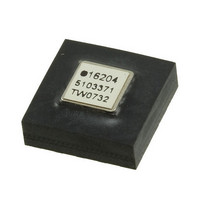ADIS16204BCCZ Analog Devices Inc, ADIS16204BCCZ Datasheet - Page 10

ADIS16204BCCZ
Manufacturer Part Number
ADIS16204BCCZ
Description
IC ACCEL DIGITAL HI-G 16-LGA
Manufacturer
Analog Devices Inc
Datasheet
1.ADIS16204PCBZ.pdf
(24 pages)
Specifications of ADIS16204BCCZ
Acceleration Range
±37g, 70g
Axis
X, Y
Sensitivity
17.125 LSB/mg, 8.407 LSB/mg
Voltage - Supply
3 V ~ 3.6 V
Output Type
Digital
Bandwidth
400Hz
Interface
SPI
Mounting Type
Surface Mount
Package / Case
16-LGA
No. Of Axes
2
Sensor Case Style
LGA
No. Of Pins
16
Supply Voltage Range
3V To 3.6V
Operating Temperature Range
-40°C To +105°C
Svhc
No SVHC (18-Jun-2010)
Family Name
ADIS16204
Package Type
LGA
Operating Supply Voltage (min)
3V
Operating Supply Voltage (typ)
3.3V
Operating Supply Voltage (max)
3.6V
Operating Temperature (min)
-40C
Operating Temperature (max)
105C
Operating Temperature Classification
Industrial
Product Depth (mm)
8mm
Product Height (mm)
5.2mm
Product Length (mm)
8mm
Mounting
Surface Mount
Pin Count
16
Interface Type
SPI
Sensitivity Per Axis
17.125mg / LSB
Rohs Compliant
Yes
Lead Free Status / RoHS Status
Lead free / RoHS Compliant
For Use With
ADIS16204/PCBZ - BOARD EVAL FOR ADIS16204/PCB
Lead Free Status / Rohs Status
Compliant
Available stocks
Company
Part Number
Manufacturer
Quantity
Price
Company:
Part Number:
ADIS16204BCCZ
Manufacturer:
ST
Quantity:
390
ADIS16204
THEORY OF OPERATION
OVERVIEW
The ADIS16204 integrates a dual-axis ±70 g/±37 g MEMS
acceleration sensor into a complete impact/shock measurement
and recording system. The integrated mixed signal processing
circuit digitizes the sensor data, applies corrections factors,
provides many user-programmable features, and offers a simple
communication conduit: the serial peripheral interface (SPI).
ACCELERATION SENSOR
The ADIS16204 base sensor core provides a fully differential
sensor structure and circuit path, resulting in substantial
rejection of electromagnetic interference (EMI) effects. It
uses electrical feedback with zero-force feedback for improved
accuracy and stability. The sensor’s resonant frequency is well
beyond the cut-off frequency of the filter, which adds further
noise rejection to the sensor signal conditioning circuit.
Figure 17 is a simplified view of one of the differential sensor
elements. Each sensor includes several differential capacitor
unit cells. Each cell is composed of fixed plates attached to the
substrate and movable plates attached to the frame. Displace-
ment of the frame changes the differential capacitance, which
is measured by the on-chip circuitry.
Complementary 200 kHz square waves drive the fixed plates.
Electrical feedback adjusts the amplitudes of the square waves
such that the ac signal on the moving plates is 0 V. The feedback
signal is linearly proportional to the applied acceleration. This
unique feedback technique ensures that there is no net electro-
static force applied to the sensor. The differential feedback control
signal is also applied to the input of the filter, where it is filtered
and converted to a single-ended signal.
TEMPERATURE SENSOR
This sensor reflects the sensor’s junction temperature and
provides a convenient temperature measurement for system-
level characterization and calibration feedback.
CAPACITORS
Figure 17. Simplified View of a Sensor Under Acceleration
SENSING
PLATE
CELL
UNIT
ANCHOR
MOVING
PLATE
FIXED
PLATES
ANCHOR
MOVABLE
FRAME
UNIT
FORCING
CELL
Rev. B | Page 10 of 24
IMPACT/SHOCK RESPONSE
The sensor’s mechanical structure provides a linear meas-
urement range that is 8 times that of each axis’ actual output
measurement range. Therefore, when considering the response
to high-g, short duration events, the 2-pole, 400 Hz, low-pass
Bessel filter network influences the output response. Figure 18
provides a frequency response for this signal chain. In Figure 19,
the X-axis accelerometer experiences a 560 g shock event that
lasts 0.1 ms, causing the output response to reach 70 g. For users
that need to avoid output saturation, keeping the integration of
the event’s acceleration response (acceleration-time product in
the case of Figure 19) below 56 g-ms is critical.
600
550
500
450
400
350
300
250
200
150
100
–10
–20
–30
–40
–50
50
10
–0.50 –0.25
0
0
10
Figure 18. ADIS16204 Frequency Response
Figure 19. ADIS16204 Shock Response
0
0.25
100
560 g , 0.1ms, SIMULATED SHOCK
FREQUENCY (Hz)
0.50
TIME (ms)
0.75
70 g , FILTERED RESPONSE
X: 418.9
Y: –3.291
1.00
1k
1.25
1.50
1.75
2.00
10k













